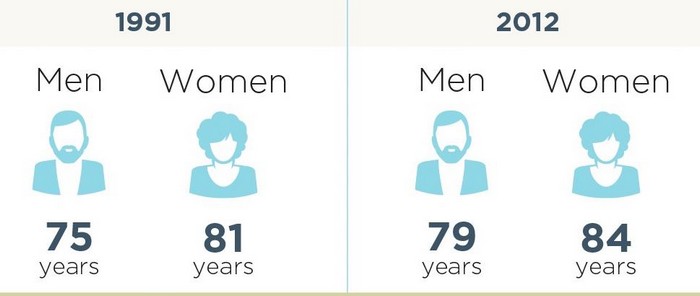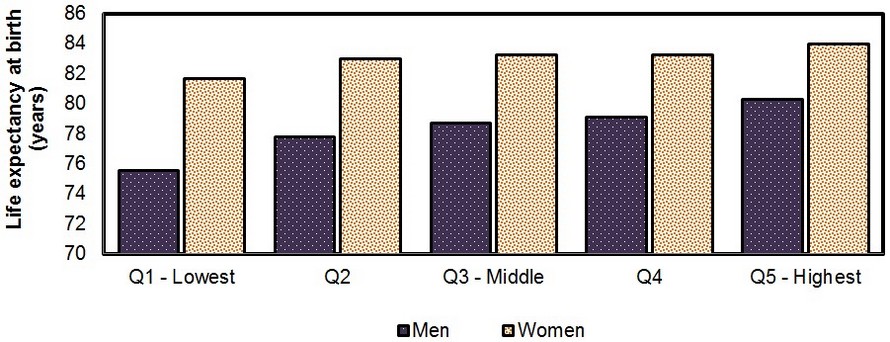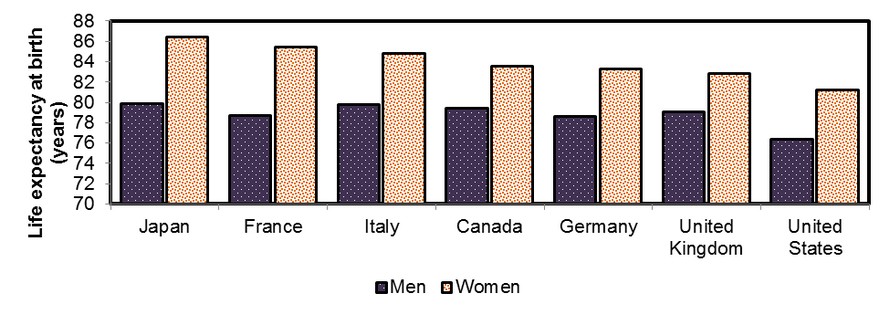Health Status of Canadians 2016: Report of the Chief Public Health Officer - How healthy are we? - Life expectancy at birth
How healthy are we?
Life expectancy at birth
In 2012, the average life expectancy at birth in Canada was estimated at 82 years.Footnote 1
Life expectancy at birth is the number of years a person is expected to live from birth onwards.Footnote 2 It is one measure of a nation's health and is affected by a variety of factors, such as genetics, lifestyle, diet, access to healthcare, education and income, and rates of diseases and conditions.Footnote 2-6
Over time, by sex
The average life expectancy at birth has increased since the early 1920s.Footnote 1,Footnote 7,Footnote 8 Women consistently have a higher life expectancy than men (see Figure 1).Footnote 1,Footnote 7,Footnote 8

Text Equivalent
This image depicts the fact that life expectancy at birth has been increase in Canada for both men and women. It also shows that women have longer life expectancies at birth than men. In 1991, men had a life expectancy at birth of 75 years while for women, it was 81 years. In 2012, men had a life expectancy at birth of 79 years while for women, it was 84 years.
By income
In urban centres in 2005-2007, life expectancy at birth for Canadians tended to be higher for people living in high-income neighbourhoods (see Figure 2)Footnote 9.

Quintiles (Q) are calculated by dividing the Canadian population into five groups of equal size (quintiles) based on neighbourhood income.
Text Equivalent
Bar chart showing life expectancy at birth in men and women by neighbourhood income based on data collected from 2005 to 2007. These data are divided into income quintiles. Quintiles are calculated by dividing the Canadian population into five groups of equal size (quintiles) based on neighbourhood income.
Men
- Quintile 1 (lowest): 75.6 years
- Quintile 2: 77.8 years
- Quintile 3: 78.7 years
- Quintile 4: 79.1 years
- Quintile 5 (highest): 80.3 years
Women
- Quintile 1 (lowest): 81.7 years
- Quintile 2: 83 years
- Quintile 3: 83.3 years
- Quintile 4: 83.3 years
- Quintile 5 (highest): 84 years
Indigenous populations
Available data suggest that Indigenous populations have lower life expectancy at birth than non-Indigenous populations.Footnote 10 Projections for 2017 suggest this is especially true for Inuit.Footnote 11
| Men | Women | |
|---|---|---|
| First Nations | 73 years | 78 years |
| Métis | 74 years | 80 years |
| Inuit | 64 years | 73 years |
| Canada (total) | 79 years | 83 years |
International comparison
In 2012, life expectancy at birth in G7 countries was highest in Japan at 80 years for men and 86 years for women and lowest in the United States at 78 years for men and 81 years for women. Canada ranked in the middle at 76 years for men and 84 years for women (see Figure 3)Footnote 12.

Text Equivalent
Bar chart showing life expectancy at birth in years for G7 countries in 2012.
Men
- Canada = 79.9 years
- United States = 76.4 years
- United Kingdom = 79.1 years
- France = 78.7 years
- Germany =78.6 years
- Italy = 79.8 years
- Japan = 79.9 years
Women
- Canada = 83.4 years
- United States = 81.2 years
- United Kingdom = 82.8 years
- France = 85.4 years
- Germany = 83.3 years
- Italy = 84.8 years
- Japan = 86.4 years
Notes to the reader
- Life expectancy is the number of years a person would be expected to live starting at birth if mortality rates stayed the same over his or her lifetime.Footnote 3
- Indigenous populations consist of First Nations, Métis and Inuit.
- G7 countries include seven of the world's industrialized countries, namely the United States, Japan, Germany, France, the United Kingdom, Italy and Canada, that form an informal discussion group and economic partnership.